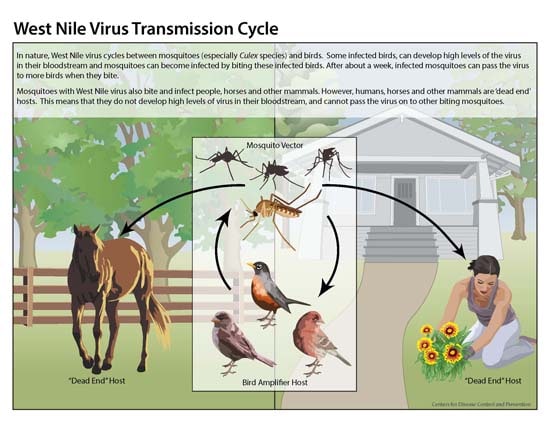
The West Nile virus (WNV) is a member of the flavivirus genus which is from the family Flaviviridae. The virus causes a neurological disease that in some cases becomes fatal. WNV is commonly found in Africa, Europe, the Middle East, North America and West Asia. It was introduced to the United States in 1999.
Hosts, Vectors, and Route of Transmission
The original hosts of the virus are birds. When mosquitos feed on birds infected with WNV, they become a vector (they carry the virus but are not affected by it themselves). Vector mosquitos then feed on other animals (commonly horses and humans) and can infect them with WNV. There have been no reports, however, that the virus can be shed from horses or humans onto other organisms, including those within the same species.

Retrieved from the CDC: http://www.cdc.gov/westnile/transmission/index.html
Clinical Signs and Prognosis
80% of those infected with WNV will be asymptomatic, however the other 20% do develop West Nile fever or severe disease. Additional signs associated with the fever are headaches, body aches, lethargy, and vomiting. About 1 in 150 people infected with WNV will develop a more severe form of the disease, which could present as West Nile encephalitis or meningitis or West Nile poliomyelitis. Signs of these conditions include headache, high fever, neck stiffness, disorientation, coma, tremors, convulsions, muscle weakness, and paralysis. There is no distinct treatment other than supportive care, and it does occasionally result in fatalities.
References
Centers for Disease Control and Prevention (2015, February 12). Transmission. Retrieved from http://www.cdc.gov/westnile/transmission/index.html.
World Health Organization (2011, July). West Nile virus. Retrieved from http://www.who.int/mediacentre/factsheets/fs354/en/.